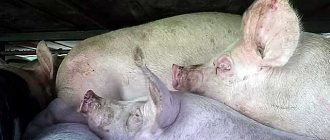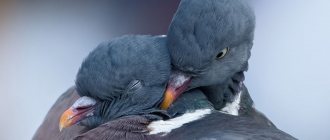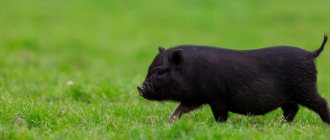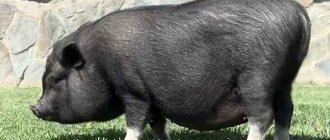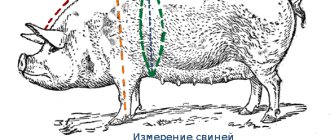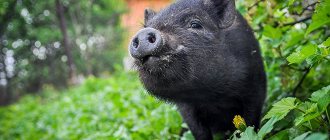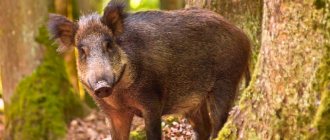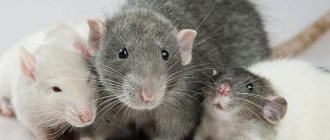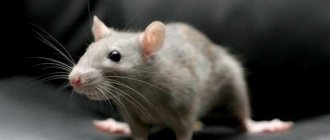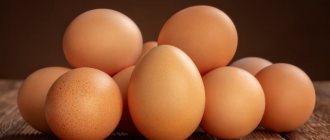For livestock farmers involved in fattening pigs, the main criterion for the success of their actions is the average daily weight gain. To control them, many owners do without special weighing equipment, but use a simpler method - a pig weight table, which allows them to find out the approximate live weight by measuring certain parameters of the body. They are carried out using an ordinary tailor's centimeter or tape measure.
The growth rate of pigs depends on various factors: the chosen breed, housing conditions, feeding ration, age and individual characteristics of the animals.
Weight table based on body size ratio
Standard indicators are combined into a table of pig weights by size. The data in it are based on the ratio of the length of the back (from the middle of the back of the head to the root of the tail) and the girth of the sternum (behind the front shoulder blades) of animals.
| Body length (cm) | Chest (cm) | Weight (kg) |
| 38 | 60 | 11 |
| 64 | 13 | |
| 68 | 15 | |
| 42 | 60 | 13 |
| 64 | 14 | |
| 68 | 16 | |
| 72 | 18 | |
| 46 | 60 | 14 |
| 64 | 16 | |
| 68 | 18 | |
| 72 | 20 | |
| 50 | 60 | 15 |
| 64 | 17 | |
| 68 | 19 | |
| 72 | 22 | |
| 76 | 24 | |
| 80 | 27 | |
| 54 | 60 | 16 |
| 64 | 18 | |
| 68 | 21 | |
| 72 | 23 | |
| 76 | 26 | |
| 80 | 29 | |
| 84 | 32 | |
| 58 | 60 | 17 |
| 64 | 19 | |
| 68 | 22 | |
| 72 | 25 | |
| 76 | 28 | |
| 80 | 31 | |
| 84 | 34 | |
| 88 | 37 | |
| 62 | 60 | 18 |
| 64 | 21 | |
| 68 | 24 | |
| 72 | 27 | |
| 76 | 30 | |
| 80 | 33 | |
| 84 | 37 | |
| 88 | 40 | |
| 92 | 43 | |
| 66 | 60 | 19 |
| 64 | 22 | |
| 68 | 25 | |
| 72 | 28 | |
| 76 | 32 | |
| 80 | 35 | |
| 84 | 39 | |
| 88 | 42 | |
| 92 | 46 | |
| 96 | 50 | |
| 70 | 64 | 24 |
| 68 | 27 | |
| 72 | 30 | |
| 76 | 34 | |
| 80 | 37 | |
| 84 | 41 | |
| 88 | 45 | |
| 92 | 49 | |
| 96 | 53 | |
| 100 | 58 | |
| 74 | 68 | 28 |
| 72 | 32 | |
| 76 | 36 | |
| 80 | 39 | |
| 84 | 44 | |
| 88 | 47 | |
| 92 | 52 | |
| 96 | 56 | |
| 100 | 61 | |
| 104 | 66 | |
| 78 | 72 | 37 |
| 76 | 41 | |
| 80 | 46 | |
| 84 | 50 | |
| 88 | 55 | |
| 92 | 59 | |
| 96 | 65 | |
| 100 | 70 | |
| 104 | 76 | |
| 82 | 76 | 39 |
| 80 | 43 | |
| 84 | 48 | |
| 88 | 52 | |
| 92 | 57 | |
| 96 | 62 | |
| 100 | 69 | |
| 104 | 74 | |
| 108 | 79 | |
| 112 | 85 | |
| 86 | 80 | 46 |
| 84 | 51 | |
| 88 | 55 | |
| 92 | 60 | |
| 96 | 65 | |
| 100 | 71 | |
| 104 | 77 | |
| 108 | 82 | |
| 112 | 89 | |
| 116 | 96 | |
| 90 | 84 | 53 |
| 88 | 58 | |
| 92 | 63 | |
| 96 | 68 | |
| 100 | 75 | |
| 104 | 81 | |
| 108 | 94 | |
| 112 | 101 | |
| 116 | 108 | |
| 94 | 88 | 60 |
| 92 | 66 | |
| 96 | 71 | |
| 100 | 78 | |
| 104 | 85 | |
| 108 | 91 | |
| 112 | 105 | |
| 116 | 113 | |
| 120 | 120 | |
| 98 | 92 | 69 |
| 96 | 74 | |
| 100 | 81 | |
| 104 | 88 | |
| 108 | 95 | |
| 112 | 101 | |
| 116 | 110 | |
| 120 | 118 | |
| 124 | 125 | |
| 128 | 133 | |
| 102 | 96 | 78 |
| 100 | 85 | |
| 104 | 92 | |
| 108 | 99 | |
| 112 | 106 | |
| 116 | 114 | |
| 120 | 123 | |
| 124 | 131 | |
| 128 | 139 | |
| 132 | 147 | |
| 106 | 100 | 88 |
| 104 | 95 | |
| 108 | 103 | |
| 112 | 110 | |
| 116 | 119 | |
| 120 | 127 | |
| 124 | 136 | |
| 128 | 144 | |
| 132 | 153 | |
| 110 | 104 | 99 |
| 108 | 107 | |
| 112 | 114 | |
| 116 | 123 | |
| 120 | 132 | |
| 124 | 141 | |
| 128 | 149 | |
| 132 | 158 | |
| 136 | 170 | |
| 140 | 180 | |
| 114 | 108 | 111 |
| 112 | 119 | |
| 116 | 128 | |
| 120 | 137 | |
| 124 | 146 | |
| 128 | 155 | |
| 132 | 176 | |
| 136 | 186 | |
| 140 | 196 | |
| 118 | 112 | 123 |
| 116 | 132 | |
| 120 | 142 | |
| 124 | 151 | |
| 128 | 160 | |
| 132 | 170 | |
| 136 | 182 | |
| 140 | 193 | |
| 144 | 203 | |
| 148 | 215 | |
| 122 | 116 | 137 |
| 120 | 146 | |
| 124 | 156 | |
| 128 | 166 | |
| 132 | 176 | |
| 136 | 188 | |
| 140 | 199 | |
| 144 | 210 | |
| 148 | 222 | |
| 126 | 120 | 151 |
| 124 | 161 | |
| 128 | 171 | |
| 132 | 181 | |
| 136 | 194 | |
| 140 | 205 | |
| 144 | 217 | |
| 148 | 229 | |
| 130 | 124 | 166 |
| 128 | 177 | |
| 132 | 187 | |
| 136 | 200 | |
| 140 | 212 | |
| 144 | 224 | |
| 148 | 236 | |
| 134 | 128 | 182 |
| 132 | 193 | |
| 136 | 206 | |
| 140 | 218 | |
| 144 | 230 | |
| 148 | 244 | |
| 138 | 132 | 199 |
| 136 | 212 | |
| 140 | 225 | |
| 144 | 237 | |
| 148 | 251 | |
| 142 | 136 | 219 |
| 140 | 231 | |
| 144 | 244 | |
| 148 | 258 | |
| 146 | 140 | 238 |
| 144 | 251 | |
| 148 | 266 | |
| 150 | 144 | 258 |
| 148 | 273 |
When measuring the length of the body, the pig's head should be positioned straight, the edges of the lower jaw, neck and chest should be in line with the belly . It is important to ensure that the measuring tape lies flat and is pressed tightly against the stubble, but does not cut into the skin. This way the error will be minimal.
Determining the weight of piglets using measurements
Experts have developed a table for measuring the weight of pigs, from which you can determine the live weight of a piglet. There is a calculation method using formulas, taking into account the fatness of the pig.
There are tables of standard weight indicators for piglets up to 10 months, from which the owner can determine whether the pet has normal weight gain or is lagging behind in development.
To calculate the live weight of a pig, you need to measure the animal.
Calculation by formula
The real live weight of young animals depends not only on the size of the body, but also on the external fatness of the animals, which is determined “by eye”.
Any owner can visually distinguish a medium-fed pig from a thin or fat one.
To more accurately determine the weight of piglets, data from similar measurements are taken and calculated using the formula:
back length (cm) × chest circumference (cm) ÷ fatness coefficient.
| External signs of a piglet | Body condition factor |
| Thick | 142 |
| Average | 156 |
| Thin | 162 |
Fatness groups
In accordance with the interstate standard in force in Russia (GOST 31476-2012), experts divide pigs intended for slaughter according to sex, age and degree of fatness into six categories or groups.
The first group includes young white bacon breeds without pigment spots (for example, Landrace) under the age of 8 months, fed using special technology. The length of the animal's body (without interception behind the shoulder blades) should be at least 1 meter, the average weight of the pig should be in the range of 70-100 kg, and the thickness of the subcutaneous fat layer in the area of the 6-7th thoracic vertebrae (above the spinous processes) should not be more than 2 cm .
For gilts of the first category, clean and healthy skin is required; the presence of rashes, bruises, tumors, injuries with damage to the subcutaneous tissue is not allowed
The second group of fatness includes young meat breeds with a live weight of 70 to 150 kg with a backfat thickness of no more than 3 cm, and gilts from 20 to 70 kg (fat with a layer of at least 1 cm).
The third group also includes pigs and boletus - young animals weighing up to 150 kg, but with a layer of fat over 3 cm.
The fourth group includes fatty pigs of universal (for example, Large White) and lard breeds - sows without restrictions on live weight, and hogs over 150 kg, with a subcutaneous fat thickness of at least 1 cm.
The fifth group consists of suckling pigs (4-10 kg each), in which the ribs and processes of the dorsal vertebrae do not protrude, and the skin is white or slightly pink, without damage.
Suckling piglets are classified into a separate (fifth) fatness category
The sixth group includes boars with a live weight of no more than 60 kg and a layer of fat from 1 cm.
Average pig weight
The weight of a pig depends primarily on the breed of the animal. So, an individual of the Great White breed will be much heavier than a Vietnamese pig.
Another factor on which the weight of an animal depends is feeding. Details that influence its set include the type of foods consumed, the presence of mixed feed in the diet, and the amount of food eaten.
The weight of an adult great white pig, common in our latitudes, depends on gender. A boar can weigh between 300-350 kg. Females weigh slightly less and have an average weight of 200-250 kg.
Did you know? The largest pig lives in Florida. Its weight is over 5 thousand kg.
Norms for age-related weight gain
When weighing piglets or determining their approximate weight using tables and formulas, owners usually focus on the age standards established for factory breed pigs:
| Growing stage | Age of young animals (days) | Live weight (kg) |
| At birth | — | 1-1,2 |
| At weaning | 42 | 8 |
| When transferring to nursery | 56 | 15 |
| When transferred for fattening | 119 | 37 |
| When weaning (at the time of slaughter) | 253 | 110 |
In this case, the optimal indicators of average daily weight gain are:
| Age | Gain (grams per day) |
| From birth to 56 days | 250 |
| From 57 to 119 days | 350 |
| From 120 to 253 days | 550 |
Monitoring the weight of animals helps to monitor their health, quickly calculate the dosage of medications if necessary, adjust the diet and achieve the most effective fattening results.
Ripening of pork meat after slaughter
After the slaughter of an individual, various processes occur in the meat that determine its quality properties. A distinction is made between rigor rigor and softening (ripening of meat).
After several days in the refrigerator at a temperature of 5-10 degrees above zero, the pork will become flavorful. The product acquires excellent taste characteristics, juice comes out of it - an indicator that the meat is ripening.
A characteristic feature is the appearance of a “dry crust” on the carcass, elasticity and a specific smell. To determine the degree of ripening of pork, histological and chemical studies are used.
Long-term storage of this product without freezing leads to a change in its consistency, color, release of watery juice and the appearance of a musty odor. As a result, putrefactive microflora develops, and the pork begins to deteriorate instantly.
Conditional assumptions
Of all the described methods for determining how much a pig or an adult pig weighs, the last one is, of course, the most approximate. It does not take into account, for example, factors such as:
- living conditions for animals;
- composition and nutritional value of feed;
- time of year - summer or winter.
According to experts, on balanced feed, the weight of an adult pig can reach 120 kilos in just six months, but if you feed it waste from the kitchen and garden, i.e. boil potatoes for it, grate grain, etc., then the animal will reach this weight only by the year.
Advice. Let's add to the last method a few more facts that are well known to experienced livestock breeders. In summer and spring, pigs gain weight much better than in the cold months, so it is most profitable to buy piglets in the spring. If you have a choice, give preference to two-month-old babies who are able to digest solid food on their own. If you have suckling piglets on your hands, you will have to supplement them with milk for the first month.
Meat is increased until maturity
With proper feeding, a Vietnamese pig gains a weight of 10 kg by the age of two months. Afterwards, the period of puberty and rapid gain of muscle mass begins. When fed with grain mixtures and mixed feed, a pig can gain up to 350-500 g per day.
At 3 months, a pig approaching reproductive age can weigh 20-25 kg. A fattening boar that has undergone the castration procedure and been sick for a week will not have much less weight - 18-20 kg.
A special feature of Asian pigs imported from Vietnam is their ability to produce offspring at an early age. Pigs reach it by 3-4 months, and boars by 4-5 months. When mating, it plays an important role how much the future sow weighs.
During this period, the livestock breeder should decide whether he is going to prepare animals for slaughter, or whether he will raise them to adulthood and leave them for breeding piglets.
In both cases, he must transfer the pigs to two meals a day in the summer and three meals a day in the winter, adding more barley, wheat and rye to the complementary food.
Corn, peas and oats, which are best absorbed by the pot-bellied pig's body, provide an increase in fat, which is considered inappropriate at this age.
How much do different breeds of pigs weigh?
The variety of pig breeds is not only great, but also amazing in shape, color and other qualities. Below we talk about the unusual varieties of pigs that can be found on a pig farm.
If you see a pig covered with thick hair, do not be alarmed. This is not a wild boar, this is one of the breeds - the Hungarian Mangalica. The light hair of the animals has a reddish color in winter, in spring it turns white and the pig is covered with funny curls. More than 40% of the animal’s genetic material comes from the roots of wild pigs, so piglets are born similar to their forest counterparts, with longitudinal stripes on the back.
The Mangalitsa is a tallow breed that was developed in the early 19th century and is still bred today. Its meat is valued because it has greasy streaks and after the drying process can be stored for up to 10 months without losing its taste. The weight of curly pigs of the Mangalitsa breed reaches 180 kg. Animals are tolerant of temperature changes, stay on pasture until late autumn, and with the onset of cold weather they make “nests” for themselves from grass and plant remains. Pigs are unpretentious in feeding; they eat the remains of alcohol processing, root vegetables, frogs and snails.
The Meishan pig breed is one of the most ancient; its pedigree includes artiodactyl ancestors that lived more than 400 years ago. The greasy pig breed is completely black in color, has a short head and the longest ears of any breed. A distinctive feature of the breed is a shortened, as if flattened, snout and drooping, “burdock-shaped” ears. The skin is also folded, and this feature is most pronounced in sows.
